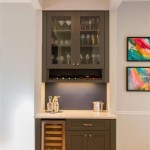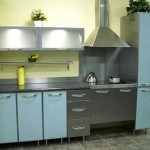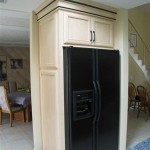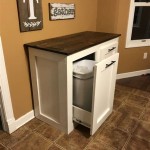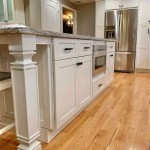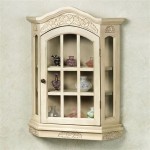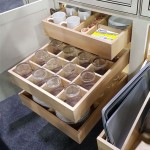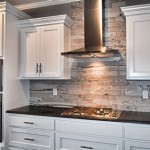How To Add Pull-Out Shelves to Corner Cabinets
Corner cabinets, often a fixture in kitchens and bathrooms, present a unique storage challenge. The deep, often inaccessible recesses can become repositories for rarely used items, leading to wasted space and organizational frustration. Adding pull-out shelves to these corner cabinets significantly improves accessibility, allowing for efficient use of every inch of storage space. This article provides a comprehensive guide on how to install pull-out shelves in corner cabinets, detailing the necessary steps, tools, and considerations for a successful project.
Before embarking on the installation process, a thorough assessment of the corner cabinet is crucial. This involves measuring the internal dimensions of the cabinet, accounting for any obstructions like plumbing or electrical wiring, and determining the desired number and configuration of the pull-out shelves. Accurate measurements are paramount for ensuring a proper fit and smooth operation once the shelves are installed. Furthermore, consider the weight capacity needed for the items that will be stored on the shelves. This will influence the choice of materials and hardware.
Next, one must select the appropriate type of pull-out shelf mechanism. Several options exist, each with its own advantages and disadvantages. Blind corner pull-outs, for instance, are designed for situations where one cabinet abuts another at a 90-degree angle. These mechanisms often feature shelves that extend out of the cabinet in two directions, maximizing the use of the often-awkward space. Lazy Susans, while not technically pull-out shelves, provide rotating access to items stored in the corner. Other options include full-extension slides for standard shelves and specialized corner pull-out systems designed for specific cabinet configurations. The choice depends largely on the cabinet's layout, the user's budget, and the intended use of the storage space.
Key Point 1: Essential Tools and Materials
Successful installation of pull-out shelves requires a selection of tools and materials. A measuring tape is essential for accurate dimensioning. A level ensures shelves are installed straight and function properly. A power drill with various drill bits is needed for creating pilot holes and attaching hardware. Screwdrivers, both Phillips head and flathead, are necessary for securing screws. A pencil is used for marking cut lines and screw locations. Safety glasses and work gloves are recommended for personal protection.
Regarding materials, the choice of shelving material depends on the desired aesthetic and weight-bearing capacity. Plywood is a common choice, offering a balance of strength and affordability. Solid wood provides a more premium look but may be more expensive. Particleboard is a less expensive option but is generally less durable and susceptible to moisture damage. The type of slide mechanism chosen will dictate the specific hardware needed, including screws, brackets, and mounting plates. Wood glue is useful for strengthening joints and preventing screws from stripping. Sandpaper is used to smooth rough edges and prepare surfaces for finishing.
The specific type of screws needed depends on the materials being joined. Wood screws are typically used for attaching shelves to cabinet frames and side panels. Self-tapping screws are useful for attaching hardware to metal components. The length of the screws should be appropriate for the thickness of the materials being joined, ensuring a secure connection without protruding through the other side.
Key Point 2: Step-by-Step Installation Process
The installation process begins with preparing the corner cabinet. This involves removing any existing shelves or obstructions and cleaning the interior surfaces. Measure the inside width, depth, and height of the cabinet to determine the maximum dimensions of the pull-out shelves. Consider the amount of clearance needed for the slide mechanism and the items that will be stored on the shelves.
Next, construct the pull-out shelves according to the measured dimensions. Cut the shelving material to the desired size using a saw. Assemble the shelves using wood glue and screws, ensuring that the corners are square and the edges are flush. Sand the edges of the shelves to remove any rough spots and create a smooth surface. Apply a finish to the shelves, such as paint or stain, to protect the wood and enhance its appearance. Allow the finish to dry completely before proceeding.
Install the slide mechanism according to the manufacturer's instructions. Typically, this involves attaching the slides to the sides of the cabinet and to the sides of the pull-out shelves. Ensure that the slides are aligned properly and that the screws are tightened securely. Test the operation of the slides to ensure that they move smoothly and without binding. Adjust the position of the slides as needed to achieve optimal performance.
Finally, install the pull-out shelves into the cabinet. Slide the shelves into the slide mechanism, ensuring that they are fully engaged. Test the operation of the shelves to ensure that they move smoothly and without rubbing against the cabinet walls. Adjust the position of the shelves as needed to achieve optimal performance. Secure the shelves in place using screws or other fasteners, if necessary.
Key Point 3: Troubleshooting Common Installation Issues
Several common issues can arise during the installation of pull-out shelves. One frequent problem is incorrect measurements, leading to shelves that are either too large or too small. To avoid this, double-check all measurements before cutting any materials. If a shelf is too large, it can be trimmed down using a saw. If a shelf is too small, it may be necessary to construct a new shelf with the correct dimensions.
Another common issue is misalignment of the slide mechanism, resulting in shelves that do not move smoothly. To correct this, loosen the screws holding the slides in place and adjust the position of the slides until the shelves move freely. Ensure that the slides are parallel to each other and that they are aligned with the front edge of the cabinet.
Binding or rubbing can also occur if the shelves are not square or if the cabinet walls are not perfectly straight. To address this, check the shelves for squareness using a square. If the shelves are not square, they may need to be disassembled and reassembled. If the cabinet walls are not straight, shims can be used to create a level surface for the slides. Another issue is the lack of sufficient weight capacity. If the shelves are sagging or bending under the weight of the stored items, stronger shelving material or a more robust slide mechanism may be needed. Reinforcing the shelves with additional supports can also help to increase their weight capacity.
Furthermore, hardware issues such as stripped screws or broken brackets can also arise. To prevent stripped screws, use the correct size drill bit to create pilot holes and avoid over-tightening the screws. If a screw becomes stripped, it can be replaced with a larger screw or a screw with coarser threads. If a bracket breaks, it should be replaced with a new bracket of the same type and size.
Finally, ensure adequate clearance for plumbing, electrical wiring, or other obstructions within the cabinet. Carefully inspect the cabinet interior and plan the shelf placement to avoid interfering with these elements. Consider using shallower shelves or modifying the shelf design to accommodate existing obstacles. Proper planning and careful execution are key to overcoming these common challenges.
By following these detailed instructions, individuals can successfully install pull-out shelves in corner cabinets, transforming previously underutilized spaces into functional and easily accessible storage areas. The improvements to organization and convenience will enhance the overall functionality of the kitchen or bathroom.

The Best Corner Cabinets For A Kitchen Remodel

Ultimate Guide To Blind Corner Cabinets

How To Make Blind Corner Cabinet Space More Useful

The Best Corner Cabinets For A Kitchen Remodel

Blind Corner Accessories Info

How To Organize Corner Kitchen Cabinets The Homes I Have Made

How To Build A Blind Corner Cabinet With Built In Drawers

How To Make Blind Corner Cabinet Space More Useful

4 Clever Corner Kitchen Cabinet Storage Ideas Oppein

20 Smart Corner Cabinet Ideas For Every Kitchen
Related Posts

